BMW MOTORRAD K 1200 S 2004 Rider's Manual (in English)
Manufacturer: BMW MOTORRAD, Model Year: 2004, Model line: K 1200 S, Model: BMW MOTORRAD K 1200 S 2004Pages: 162, PDF Size: 2.99 MB
Page 151 of 162
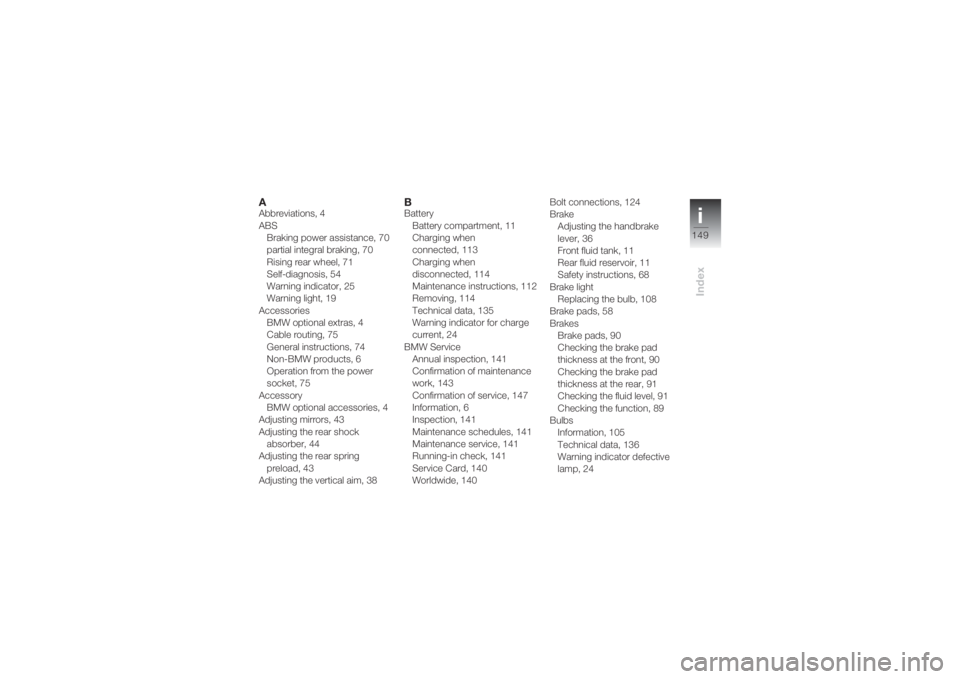
i149
Index
AAbbreviations, 4
ABS
Braking power assistance, 70
partial integral braking, 70
Rising rear wheel, 71
Self-diagnosis, 54
Warning indicator, 25
Warning light, 19
Accessories
BMW optional extras, 4
Cable routing, 75
General instructions, 74
Non-BMW products, 6
Operation from the power
socket, 75
Accessory
BMW optional accessories, 4
Adjusting mirrors, 43
Adjusting the rear shock
absorber, 44
Adjusting the rear spring
preload, 43
Adjusting the vertical aim, 38
BBattery
Battery compartment, 11
Charging when
connected, 113
Charging when
disconnected, 114
Maintenance instructions, 112
Removing, 114
Technical data, 135
Warning indicator for charge
current, 24
BMW Service
Annual inspection, 141
Confirmation of maintenance
work, 143
Confirmation of service, 147
Information, 6
Inspection, 141
Maintenance schedules, 141
Maintenance service, 141
Running-in check, 141
Service Card, 140
Worldwide, 140Bolt connections, 124
Brake
Adjusting the handbrake
lever, 36
Front fluid tank, 11
Rear fluid reservoir, 11
Safety instructions, 68
Brake light
Replacing the bulb, 108
Brake pads, 58
Brakes
Brake pads, 90
Checking the brake pad
thickness at the front, 90
Checking the brake pad
thickness at the rear, 91
Checking the fluid level, 91
Checking the function, 89
Bulbs
Information, 105
Technical data, 136
Warning indicator defective
lamp, 24
Page 152 of 162
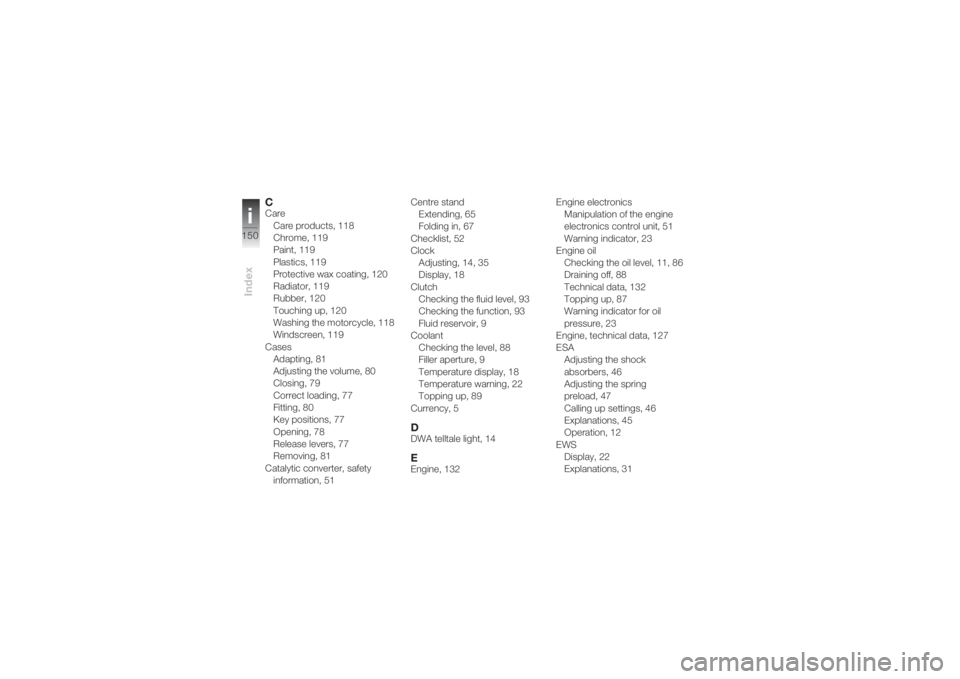
Indexi150
CCare
Care products, 118
Chrome, 119
Paint, 119
Plastics, 119
Protective wax coating, 120
Radiator, 119
Rubber, 120
Touching up, 120
Washing the motorcycle, 118
Windscreen, 119
Cases
Adapting, 81
Adjusting the volume, 80
Closing, 79
Correct loading, 77
Fitting, 80
Key positions, 77
Opening, 78
Release levers, 77
Removing, 81
Catalytic converter, safety
information, 51Centre stand
Extending, 65
Folding in, 67
Checklist, 52
Clock
Adjusting, 14, 35
Display, 18
Clutch
Checking the fluid level, 93
Checking the function, 93
Fluid reservoir, 9
Coolant
Checking the level, 88
Filler aperture, 9
Temperature display, 18
Temperature warning, 22
Topping up, 89
Currency, 5
DDWA telltale light, 14EEngine, 132Engine electronics
Manipulation of the engine
electronics control unit, 51
Warning indicator, 23
Engine oil
Checking the oil level, 11, 86
Draining off, 88
Technical data, 132
Topping up, 87
Warning indicator for oil
pressure, 23
Engine, technical data, 127
ESA
Adjusting the shock
absorbers, 46
Adjusting the spring
preload, 47
Calling up settings, 46
Explanations, 45
Operation, 12
EWS
Display, 22
Explanations, 31
Page 153 of 162
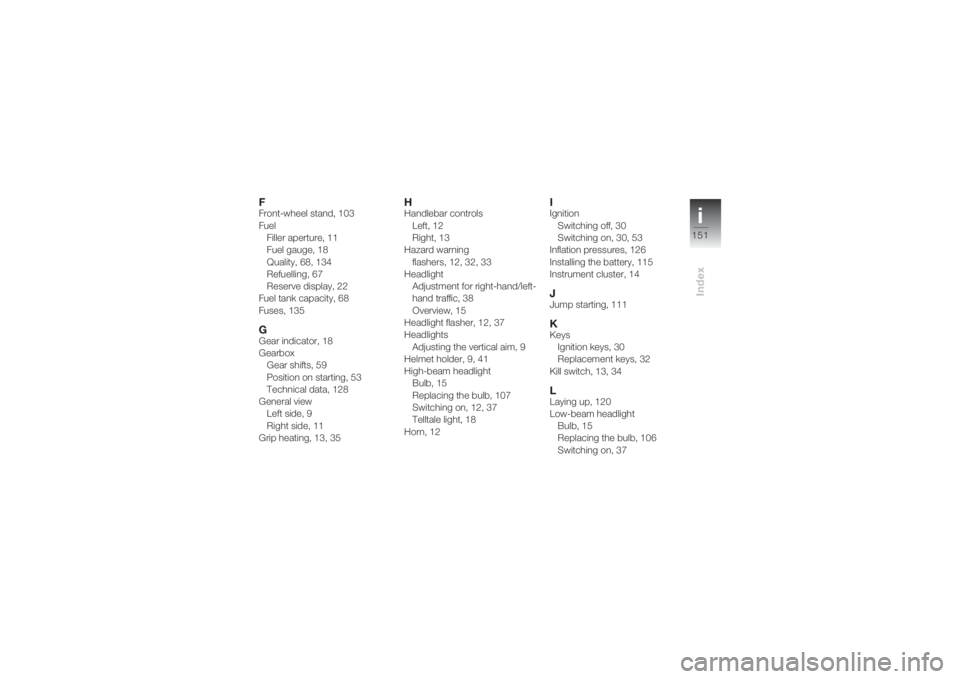
i151
Index
FFront-wheel stand, 103
Fuel
Filler aperture, 11
Fuel gauge, 18
Quality, 68, 134
Refuelling, 67
Reserve display, 22
Fuel tank capacity, 68
Fuses, 135GGear indicator, 18
Gearbox
Gear shifts, 59
Position on starting, 53
Technical data, 128
General view
Left side, 9
Right side, 11
Grip heating, 13, 35
HHandlebar controls
Left, 12
Right, 13
Hazard warning
flashers, 12, 32, 33
Headlight
Adjustment for right-hand/left-
hand traffic, 38
Overview, 15
Headlight flasher, 12, 37
Headlights
Adjusting the vertical aim, 9
Helmet holder, 9, 41
High-beam headlight
Bulb, 15
Replacing the bulb, 107
Switching on, 12, 37
Telltale light, 18
Horn, 12
IIgnition
Switching off, 30
Switching on, 30, 53
Inflation pressures, 126
Installing the battery, 115
Instrument cluster, 14JJump starting, 111KKeys
Ignition keys, 30
Replacement keys, 32
Kill switch, 13, 34LLaying up, 120
Low-beam headlight
Bulb, 15
Replacing the bulb, 106
Switching on, 37
Page 154 of 162
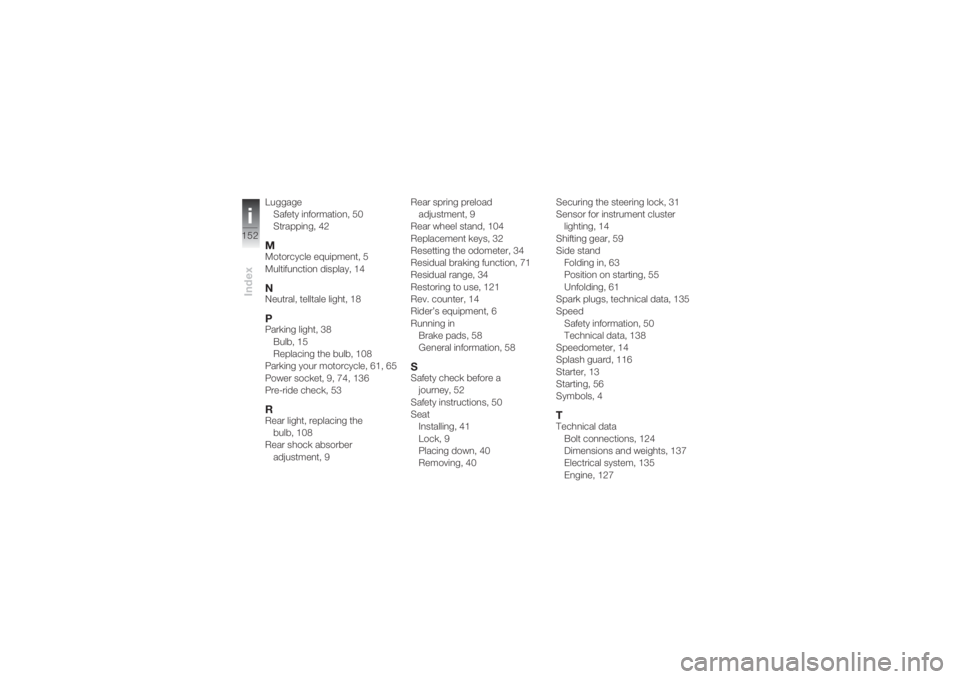
Indexi152
Luggage
Safety information, 50
Strapping, 42MMotorcycle equipment, 5
Multifunction display, 14NNeutral, telltale light, 18PParking light, 38
Bulb, 15
Replacing the bulb, 108
Parking your motorcycle, 61, 65
Power socket,9,74,136
Pre-ride check, 53RRear light, replacing the
bulb, 108
Rear shock absorber
adjustment, 9Rear spring preload
adjustment, 9
Rear wheel stand, 104
Replacement keys, 32
Resetting the odometer, 34
Residual braking function, 71
Residual range, 34
Restoring to use, 121
Rev. counter, 14
Rider’s equipment, 6
Running in
Brake pads, 58
General information, 58
SSafety check before a
journey, 52
Safety instructions, 50
Seat
Installing, 41
Lock, 9
Placing down, 40
Removing, 40Securing the steering lock, 31
Sensor for instrument cluster
lighting, 14
Shifting gear, 59
Side stand
Folding in, 63
Position on starting, 55
Unfolding, 61
Spark plugs, technical data, 135
Speed
Safety information, 50
Technical data, 138
Speedometer, 14
Splash guard, 116
Starter, 13
Starting, 56
Symbols, 4
TTechnical data
Bolt connections, 124
Dimensions and weights, 137
Electrical system, 135
Engine, 127
Page 155 of 162
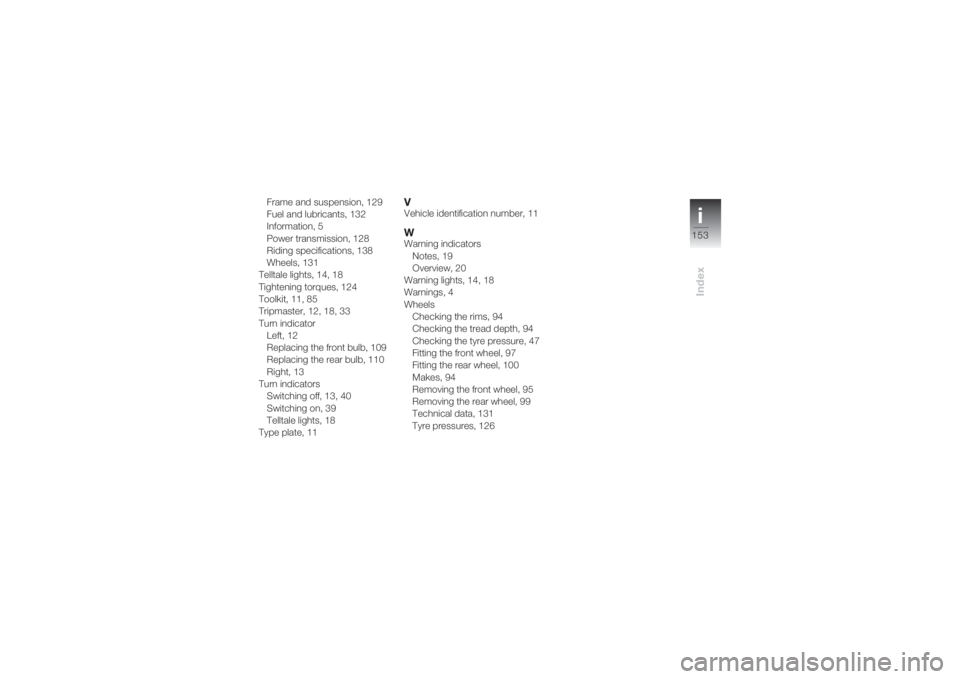
i153
Index
Frame and suspension, 129
Fuel and lubricants, 132
Information, 5
Power transmission, 128
Riding specifications, 138
Wheels, 131
Telltale lights, 14, 18
Tightening torques, 124
Toolkit, 11, 85
Tripmaster, 12, 18, 33
Turn indicator
Left, 12
Replacing the front bulb, 109
Replacing the rear bulb, 110
Right, 13
Turn indicators
Switching off, 13, 40
Switching on, 39
Telltale lights, 18
Type plate, 11
VVehicle identification number, 11WWarning indicators
Notes, 19
Overview, 20
Warning lights, 14, 18
Warnings, 4
Wheels
Checking the rims, 94
Checking the tread depth, 94
Checking the tyre pressure, 47
Fitting the front wheel, 97
Fitting the rear wheel, 100
Makes, 94
Removing the front wheel, 95
Removing the rear wheel, 99
Technical data, 131
Tyre pressures, 126
Page 156 of 162
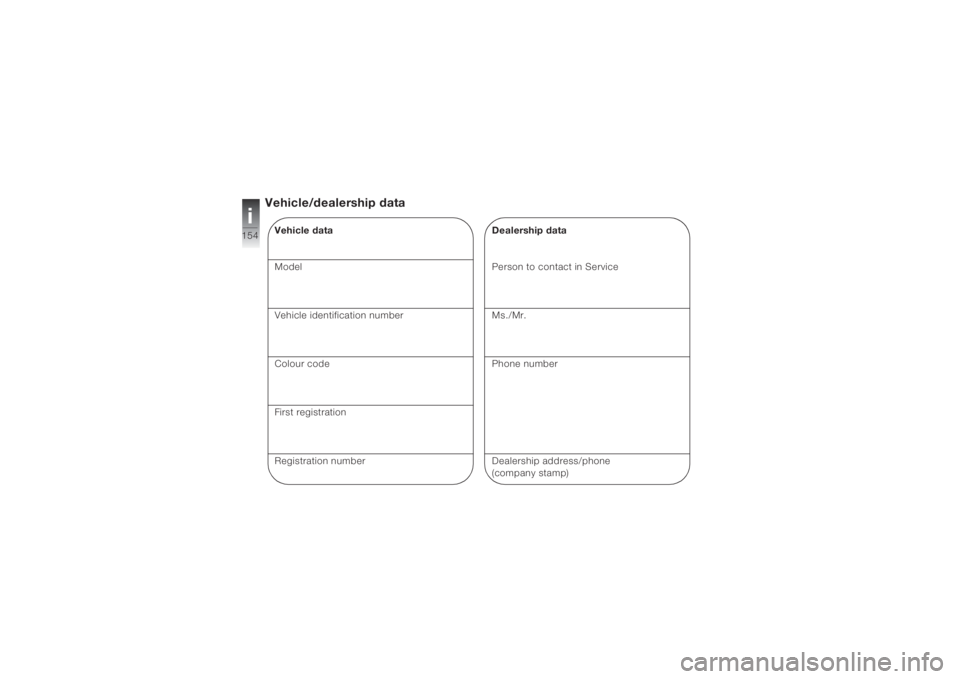
i154
Vehicle/dealership dataVehicle data
Model
Vehicle identification number
Colour code
First registration
Registration number
Dealership data
Person to contact in Service
Ms./Mr.
Phone number
Dealership address/phone
(company stamp)
Page 157 of 162
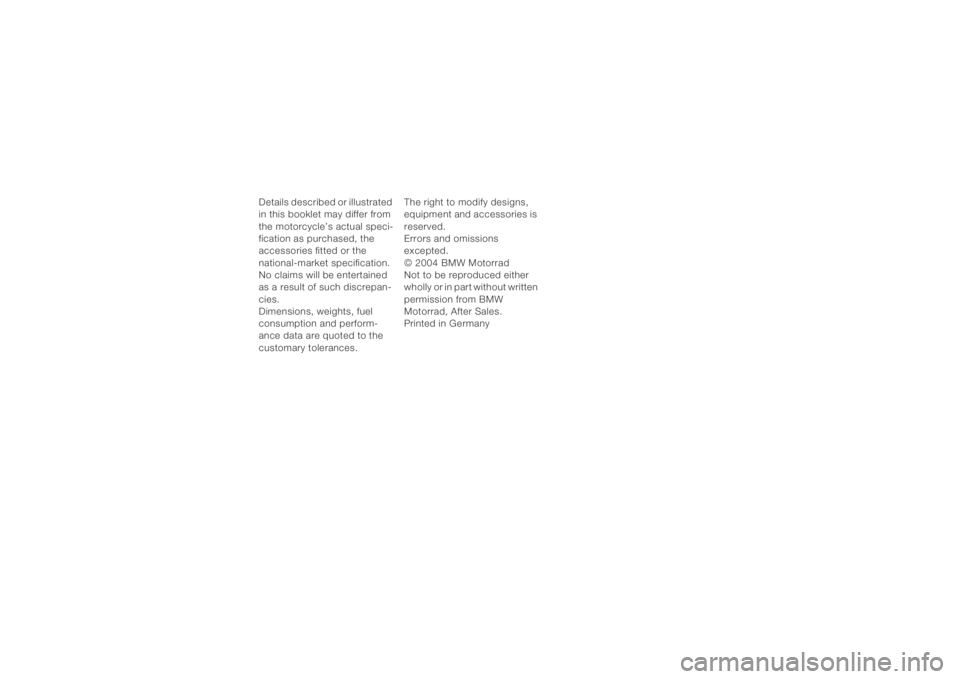
9
Details described or illustrated
in this booklet may differ from
the motorcycle’s actual speci-
fication as purchased, the
accessories fitted or the
national-market specification.
No claims will be entertained
as a result of such discrepan-
cies.
Dimensions, weights, fuel
consumption and perform-
ance data are quoted to the
customary tolerances.The right to modify designs,
equipment and accessories is
reserved.
Errors and omissions
excepted.
© 2004 BMW Motorrad
Not to be reproduced either
wholly or in part without written
permission from BMW
Motorrad, After Sales.
Printed in Germany
Page 158 of 162
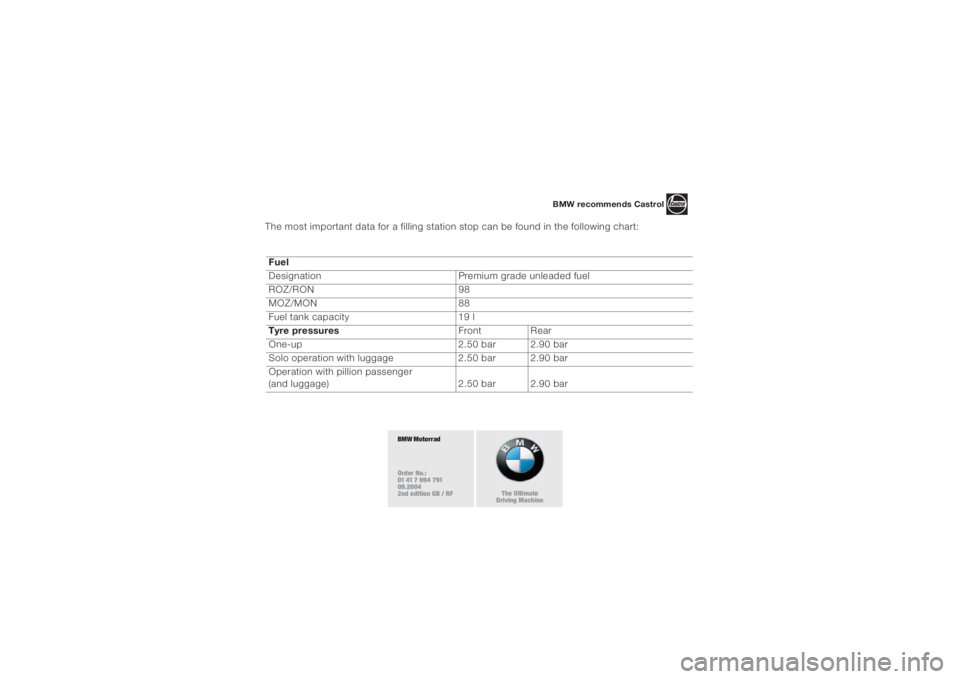
9
The most important data for a filling station stop can be found in the following chart:
Fuel
Designation Premium grade unleaded fuel
ROZ/RON 98
MOZ/MON 88
Fuel tank capacity 19 l
Tyre pressuresFront Rear
One-up 2.50 bar 2.90 bar
Solo operation with luggage 2.50 bar 2.90 bar
Operation with pillion passenger
(and luggage) 2.50 bar 2.90 bar
BMW recommends Castrol
BMW Motorrad
Order No.:
01 41 7 694 791
09.2004
2nd edition GB / RF
The Ultimate
Driving Machine
Page 159 of 162
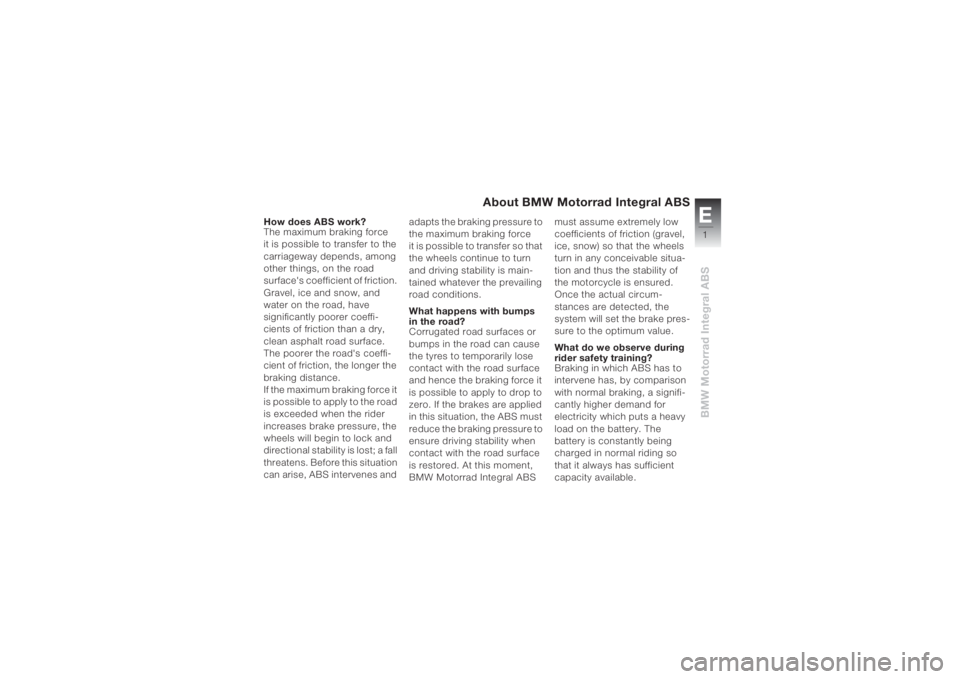
E1BMW Motorrad Integral ABS
About BMW Motorrad Integral ABS
How does ABS work?
The maximum braking force
it is possible to transfer to the
carriageway depends, among
other things, on the road
surface's coefficient of friction.
Gravel, ice and snow, and
water on the road, have
significantly poorer coeffi-
cients of friction than a dry,
clean asphalt road surface.
The poorer the road's coeffi-
cient of friction, the longer the
braking distance.
If the maximum braking force it
is possible to apply to the road
is exceeded when the rider
increases brake pressure, the
wheels will begin to lock and
directional stability is lost; a fall
threatens. Before this situation
can arise, ABS intervenes and adapts the braking pressure to
the maximum braking force
it is possible to transfer so that
the wheels continue to turn
and driving stability is main-
tained whatever the prevailing
road conditions.
What happens with bumps
in the road?
Corrugated road surfaces or
bumps in the road can cause
the tyres to temporarily lose
contact with the road surface
and hence the braking force it
is possible to apply to drop to
zero. If the brakes are applied
in this situation, the ABS must
reduce the braking pressure to
ensure driving stability when
contact with the road surface
is restored. At this moment,
BMW Motorrad Integral ABS must assume extremely low
coefficients of friction (gravel,
ice, snow) so that the wheels
turn in any conceivable situa-
tion and thus the stability of
the motorcycle is ensured.
Once the actual circum-
stances are detected, the
system will set the brake pres-
sure to the optimum value.
What do we observe during
rider safety training?
Braking in which ABS has to
intervene has, by comparison
with normal braking, a signifi-
cantly higher demand for
electricity which puts a heavy
load on the battery. The
battery is constantly being
charged in normal riding so
that it always has sufficient
capacity available. Info_I_ABS_en_xx.fm Seite 1 Dienstag, 19. Juli 2005 2:48 14
Page 160 of 162
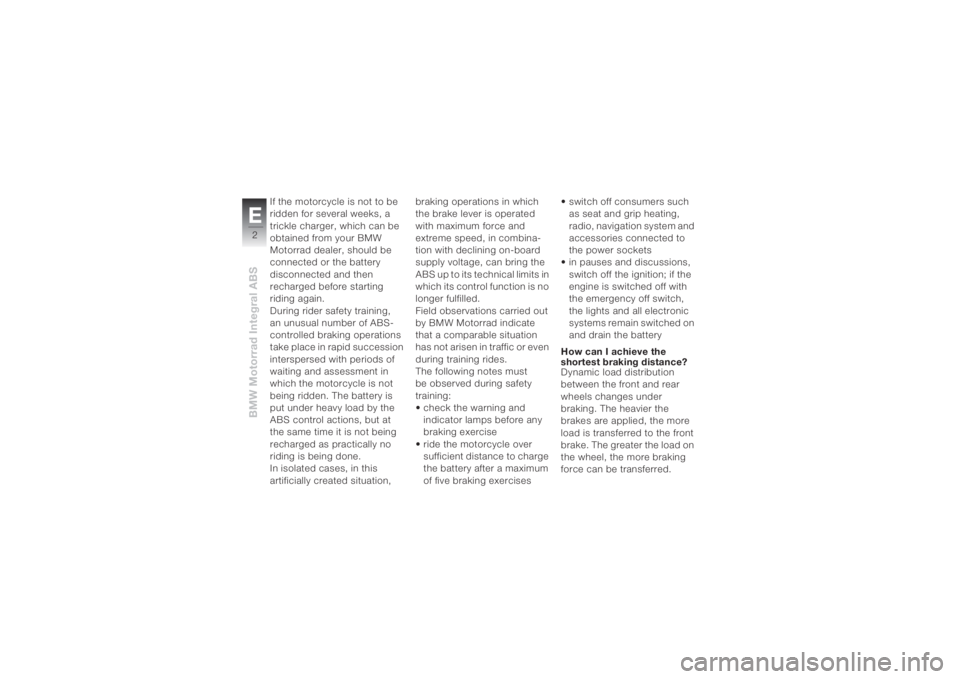
BMW Motorrad Integral ABSE2
If the motorcycle is not to be
ridden for several weeks, a
trickle charger, which can be
obtained from your BMW
Motorrad dealer, should be
connected or the battery
disconnected and then
recharged before starting
riding again.
During rider safety training,
an unusual number of ABS-
controlled braking operations
take place in rapid succession
interspersed with periods of
waiting and assessment in
which the motorcycle is not
being ridden. The battery is
put under heavy load by the
ABS control actions, but at
the same time it is not being
recharged as practically no
riding is being done.
In isolated cases, in this
artificially created situation, braking operations in which
the brake lever is operated
with maximum force and
extreme speed, in combina-
tion with declining on-board
supply voltage, can bring the
ABS up to its technical limits in
which its control function is no
longer fulfilled.
Field observations carried out
by BMW Motorrad indicate
that a comparable situation
has not arisen in traffic or even
during training rides.
The following notes must
be observed during safety
training:
• check the warning and
indicator lamps before any
braking exercise
• ride the motorcycle over
sufficient distance to charge
the battery after a maximum
of five braking exercises• switch off consumers such
as seat and grip heating,
radio, navigation system and
accessories connected to
the power sockets
• in pauses and discussions,
switch off the ignition; if the
engine is switched off with
the emergency off switch,
the lights and all electronic
systems remain switched on
and drain the battery
How can I achieve the
shortest braking distance?
Dynamic load distribution
between the front and rear
wheels changes under
braking. The heavier the
brakes are applied, the more
load is transferred to the front
brake. The greater the load on
the wheel, the more braking
force can be transferred.Info_I_ABS_en_xx.fm Seite 2 Dienstag, 19. Juli 2005 2:48 14